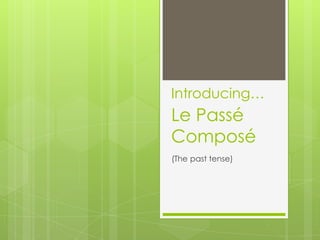
Paige Rogers Powerpoint 1
- 1. Introducing… Le Passé Composé (The past tense)
- 2. Le Passé Composé The past tense is used to describe things that have already happened. “J’ai mangé de la pizza.” “I ate some pizza” Thisis a two part verb tense made up of the auxiliary verb and the past participle.
- 3. Le Participe Passé (The Past Participle) The past participle is the second of the two verbs used in passé composé and constitutes the action that was done in the past. Ex: “J’ai ÉTUDIÉ hier soir.” Verbs ending in –er retain their stem and end with –é Aller – allé Étudier – étudié Manger - mangé
- 4. Le Participe Passé Cont. Verbs ending in –ir retain their stem and end with –i instead. Dormir – dormi Choisir – choisi Partir – parti
- 5. Le Participe Passé Cont. Verbsending in –re retain their stem as well and end in –u Attendre – attendu Battre – battu Rendre – rendu
- 6. Le Participe Passé Irregulier Some verbs don’t follow the usual patterns. The most common are… Être – été Faire – fait Avoir – eu The following end in –u: Boire – bu connaître – connu lire – lu The following end in –it: Conduire – conduit Dire – dit Écrire – écrit There are more irregulars but these are the most common. The rest we will learn as we come to them.
- 7. Auxiliary Verbs There are two choices for the auxiliary verb; either “avoir” or “être”. Most verbs use “avoir” with only a few using “être”, but both are placed before the past participial and conjugated according to the subject.
- 8. Conjugating “Avoir” manger J’ ai mangé Nous avons mangé Tu as mangé Vous avez mangé Il/Elle/On a mangé Ils/Elles ont mangé “Avoir” is used with the vast majority of verbs like manger, faire, nager, ect.
- 9. Conjugating “Être” Aller Je suis allé(e) Nous Sommes allé(e)s Tu es allé(e) Vous Êtes allé(e)(s) Il/Elle/On est allé(e) Ils/Elles Sont allé(e)s Verbs that use “être” have an extra rule compared to verbs with “avoir,” they have to agree with the subject. This means that you have to add an “e” to the end if the subject is feminine and you have to add an “s” is the subject is plural.
- 10. Verbs that use “Être” Devenir Aller Revenir Retouner Naître Arriver Mourir Descendre Monter Rester Entrer Passer Sortir Rentrer Partir Venir Tomber Apart from the above verbs the only verbs that use “être” are reflexive verbs. These are verbs like se coucher, se maquiller, se lever, ect.
- 11. Verb Agreement As stated before, verbs that use “être” add either an “e” and/or an “s” to the end of the participe passé in order to agree with the subject. The only other time this happens is when there is a direct object precedes the verb. Elle l’a regardée
- 12. Using Le Passé Composé Communicating completed, isolated events in the past. These are events that are not habitual. Furthersthe story of the narrator by expressing a series of actions. Used to show a change in state of being or a reaction.
- 13. Practicing Le Passé Composé Je/J’ ai écouté (avoir/écouter) de la musique. Elle a nagé (avoir/nager) à la piscine. Nous avons choisi (avoir/choisir) la nourriture pour le fête. Ils ont attendu (avoir/attendre) pour les resultats.
- 14. Practicing Le Passé Composé Je/J’ suis allé(e) (être/aller) à la bibliothèque. Elle est partie (être/partir) à huit heure ce matin! Nous nous sommes couché(e)s (être/se coucher) trop retard hier soir. Ils sont descendu (être/descendre) les escaliers.
- 15. Bibliography Williams-Gascon, Ann, Carmen Grace, and Christian Roche. "Structures Pour Communiquer 1." Bien Vu, Bien Dit: Intermediate French. San Francisco, CA: McGraw-Hill, 2008. 157-60. Print. Rogers, Paige C. French Notes, 2011